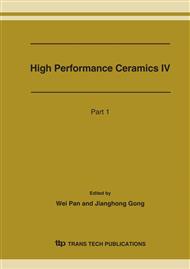p.279
p.283
p.287
p.290
p.293
p.297
p.301
p.304
p.307
Preparation and Microwave Dielectric Properties of (1-x)Ca2/5Sm2/5TiO3 -x Li1/2Nd1/2TiO3 Ceramics
Abstract:
(1-x) Ca2/5Sm2/5TiO3-x Li1/2Nd1/2TiO3 (CSLNT) ceramics, suitable for use in resonators or filters at microwave frequency, have a high εr and a low temperature coefficient of resonant frequency. The effects of calcinations on the microwave dielectric properties of CSLNT were studied. The CSLNT (x = 0.3) ceramics sintered at 1300oC for 3 h showed microwave properties with εr of 92, Qf of 5060 GHz and τf of 7.5 ppm/oC. The microwave dielectric properties of CSLNT (x = 0.3) ceramics were also improved by soft chemistry methods such as citric acid gel route and ethylenediaminetetraacetic acid (EDTA) chelating method. The excellent microwave properties with εr = 96, Qf = 6290 GHz and τf = 6 ppm/oC were obtained by EDTA chelating method for CSLNT (x = 0.3) ceramics.
Info:
Periodical:
Pages:
293-296
Citation:
Online since:
April 2007
Authors:
Price:
Сopyright:
© 2007 Trans Tech Publications Ltd. All Rights Reserved
Share:
Citation:


